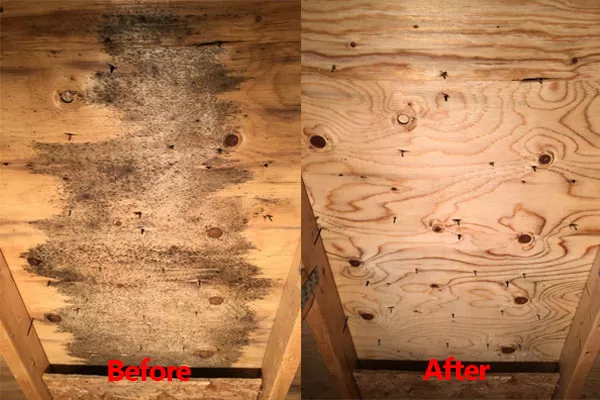Attic Mold Removal
The attic is one of the most common areas for mold growth, and most people don’t find this out until they are trying to sell their home, upgrade their insulation and are informed by the home inspector or insulation installer. We can help by safely removing the mold in the attic and correcting the source of the cause permanently and guaranteed. Clearance certificates and guarantees will ensure peace of mind to the owner and buyer.

Causes of mold in the attic water damage and excessive moisture causes mold and this is no different in the attic. Most of the time, condensation occurs in your attic due to ventilation issues which in turn causes leaks and moisture. This causes mildew, wood rot and interior water damage. Over time, mold grows and if left untreated, it becomes a big problem if not dealt with.
We do not recommend eliminating mould on your own and we do advise calling professionals for any mould growth found to cover an area of 10 square feet or more, or in any situation in which you are unsure where else mould may have spread.
Types of Mold
Acremonium
Typically grows in humidifiers, cooling coils, drain pans & window sealants. Its appearance evolves and changes over time.
Alternaria
The most common form of allergenic mold in the world. Typically grows wherever dampness occurs (showers, bathtubs & below leaking sinks).
Aspergillosis
Commonly found in households. There are over 185 species, appearing in many different colours.
Aureobasidium
An allergic mold. Can sometimes be found growing behind wallpaper or on painted or wooden surfaces.
Chaetomium
Commonly found in water-damaged homes and buildings. It has a cotton-like texture and usually changes colours over time.
Cladosporium
Can grow in both warm and cold conditions. Often found thriving in indoor materials such as fabrics, upholsteries, and carpets.
Fusarium
Capable of growing and spreading in cold temperatures. An allergenic and toxigenic type of mold that grows in homes with water damage
Mucor
Allergenic form of mold that usually grows in thick patches, near air conditions, HVAC systems and ducting due to moisture from condensation.
Penicillin
Allergenic form of mold easily recognizable by its blue or green coloured surface with a velvety texture. Often found in water damaged buildings.
Stachybotrys
Also known as “black mold.” Toxigenic type of mold that can cause allergic reactions. Thrives in damp, wet areas with high humidity levels.
Trichoderma
Allergenic mold type generally white in colour with green patches. Commonly grows in the home on wet surfaces and moist areas.
Localism
Thrives in wetness and water and is usually black in colour. Can be found in kitchens, bathrooms, basements, and around windows with high condensation